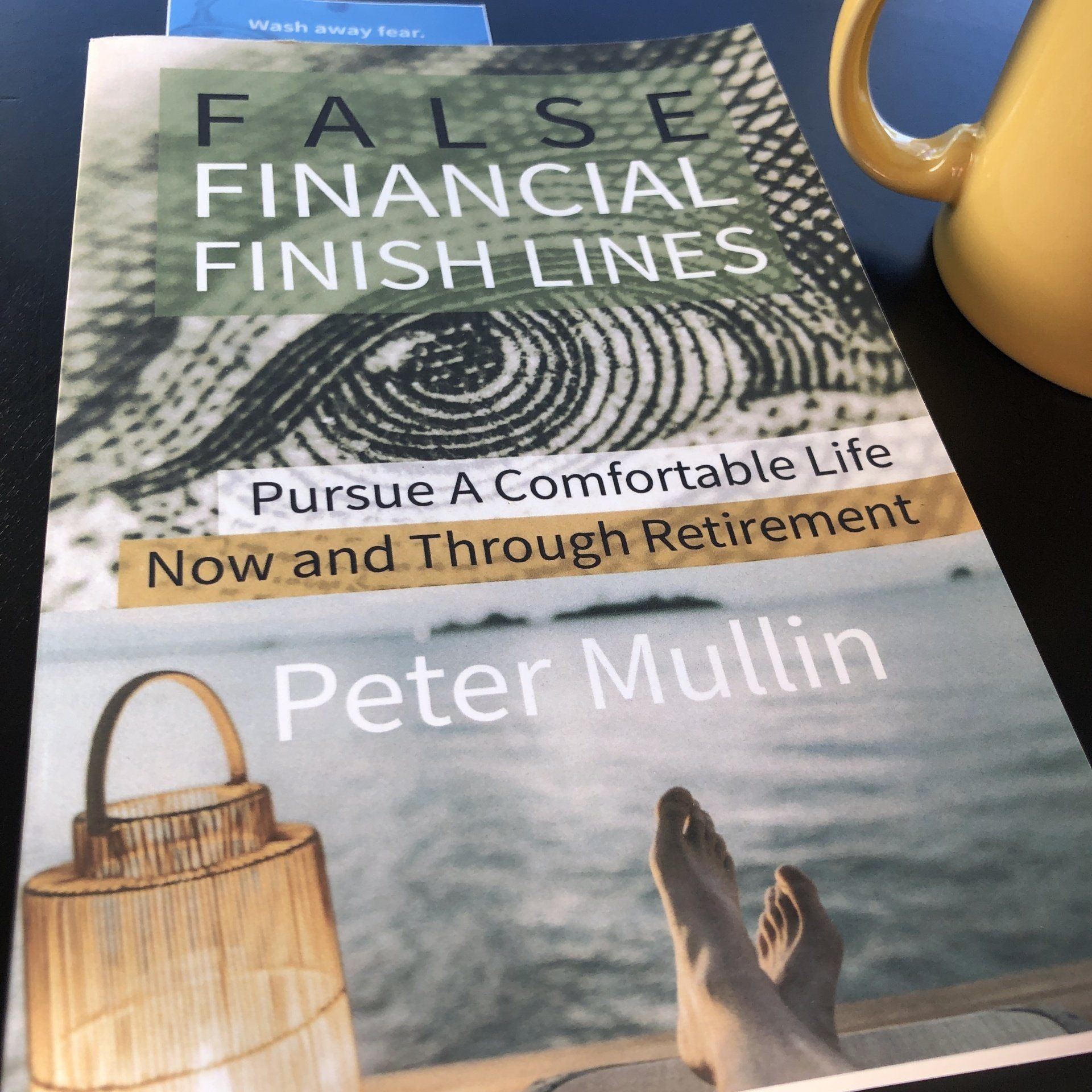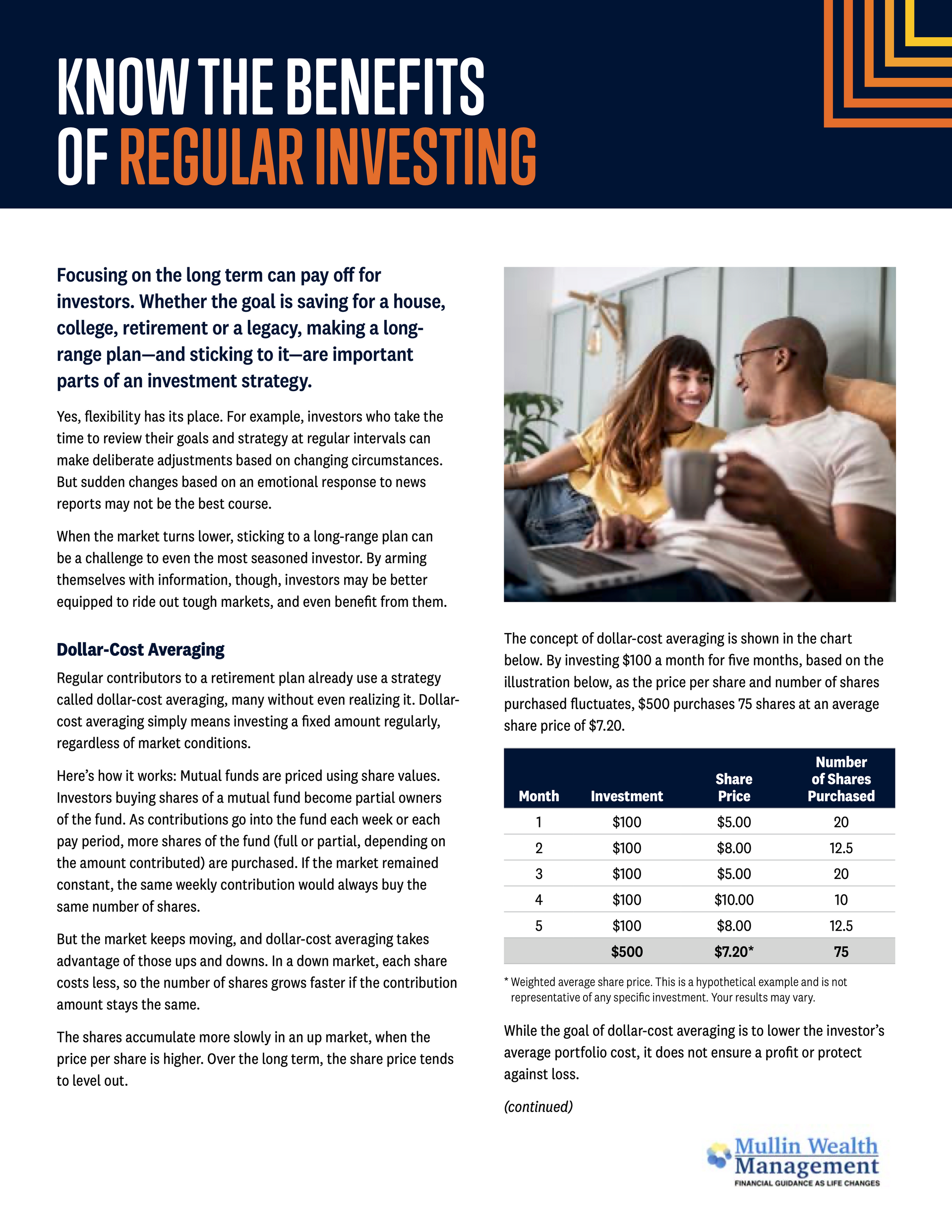Know the benefits of regular investing
KNOW THE BENEFITS OF REGULAR INVESTING
Focusing on the long term can pay off for investors. Whether the goal is saving for a house, college, retirement or a legacy, making a long- range plan—and sticking to it—are important parts of an investment strategy.
Yes, flexibility has its place. For example, investors who take the time to review their goals and strategy at regular intervals can make deliberate adjustments based on changing circumstances. But sudden changes based on an emotional response to news reports may not be the best course.
When the market turns lower, sticking to a long-range plan can be a challenge to even the most seasoned investor. By arming themselves with information, though, investors may be better equipped to ride out tough markets, and even benefit from them.
Dollar-Cost Averaging
Regular contributors to a retirement plan already use a strategy called dollar-cost averaging, many without even realizing it. Dollar- cost averaging simply means investing a fixed amount regularly, regardless of market conditions.
Here’s how it works: Mutual funds are priced using share values. Investors buying shares of a mutual fund become partial owners of the fund. As contributions go into the fund each week or each pay period, more shares of the fund (full or partial, depending on the amount contributed) are purchased. If the market remained constant, the same weekly contribution would always buy the same number of shares.
But the market keeps moving, and dollar-cost averaging takes advantage of those ups and downs. In a down market, each share costs less, so the number of shares grows faster if the contribution amount stays the same.
The shares accumulate more slowly in an up market, when the price per share is higher. Over the long term, the share price tends to level out.
The concept of dollar-cost averaging is shown in the chart below. By investing $100 a month for five months, based on the illustration below, as the price per share and number of shares purchased fluctuates, $500 purchases 75 shares at an average share price of $7.20.
Taking Advantage of Market Movements
During periods of extreme market fluctuations, dollar-cost averaging investors may have more return potential. The more frequently the market dips, the more opportunities there are to buy at lower prices. In this way, the investor’s account can accumulate many more shares of the fund that may benefit from future up markets.
Making regular contributions is one important factor in successful long-term investing. You should consider your ability to continue purchasing through fluctuating price levels. By making a plan, sticking to it, and taking advantage of dollar-cost averaging, investors are following a widely used strategy to work toward their investment goals.
Dollar cost averaging involves continuous investment in securities regardless of fluctuation in price levels of such securities. An investor should consider their ability to continue purchasing through fluctuating price levels. Such a plan does not assure a profit and does not protect against loss in declining markets.
This material was prepared by LPL Financial, LLC.
This material is for educational and informational purposes only and is not intended as ERISA, tax, legal or investment advice. If you are seeking investment advice specific to your needs, such advice services must be obtained on your own separate from this educational material.
Securities and advisory services offered through LPL Financial, a registered investment advisor, Member FINRA/SIPC. LPL Financial and Mullin Wealth Management are separate entities.
Tracking #1-05365584 (Exp. 03/25)
- Mullin's take on the "4% Retirement Rule"
- Navigate "Bad Portfolio Weather"
- Tips to Optimize Social Security







Articles and Assets
What are your Priorities?
Well it’s the end of the year. I just searched on Google for “market outlook 2018.” I came up with a little over 58-million “results.”
So should you be investing in stocks in 2018? The quick answer: It’s likely a prudent part of your portfolio. But it depends on your circumstances, right?
It’s apparently popular to throw your hat in the ring.
A mantra that you hear among disciplined professionals is to “stay the course.”
Then you hear “sell high, buy low.”
Who’s right?
The relief of a disciplined strategy is that it can be tailored to you. And tailor we think you should.
Yes, it’s possible that an investor may not utilize stocks in their portfolio at all. Or you may decide to go “all in” with a diversified stock portfolio.
(Side effects from tailoring a strategy may include increased confidence & persistence, apathy toward daily market reports, and increased focus on what really matters.)
Let’s begin with the “Why” of investing for you. Then you can request 15-minutes on the phone discuss your “how.”
So “Why Should You Invest”
Life changes and our “why” of investing ought to transform with life. Some invest for sport – they like the risk/reward of investing – they’re in it for the thrill. I don’t hang with this crowd.
Most of us ought to invest for things we want. Our money & our goals are serious. By investing in a diversified portfolio we can pursue things we want.
1. Living A Comfortable Retirement: Retirement is a noun. It’s up to you to really design and live a retirement that reflects you.
2. Purchasing a Home: Home is a place to live. It can take a down payment.
3. Passing an Inheritance on to Family:
4. Student Loan Shield: This idea is important for many Millennial graduates. Student loans can dominate your budget. But instead of accelerating those payments, what if you paid your required payments, and then invested the additional money that you were going to pay against your loan balance?
5. Emergency Reserves: You probably have read that it’s prudent to keep a relative healthy amount of cash in your checking/savings. Once you’ve achieved that, then you can consider investing additional funds. Go a step further and consider a non-retirement account for you and your house. You can spend this on cars, vacations or use it just as described in #4.
The Dow Jones has seen positive results, so far, in 2017. It’s unusual and sort of uncomfortable as the independent financial advisor. Why is it uncomfortable?
What would sting & linger longer? Finding $20 in the parking lot? Or finding a $20 parking fine on your windshield?
We’ve been finding a lot of metaphorical “$20’s” (i.e. “positive results”) in our portfolios this year. So the second we find a parking fine (or a few in a row) we’ll be sure to ask if stocks are still the right place to park our money.
Complacency can work against us, Dear Clients. Just keep recalling your long-haul strategy and your “why” of investing.
***
Peter Mullin is an independent financial advisor registered through LPL Financial. He lives in Rogers, MN with his family. He was born and raised in St. Cloud, MN. Mullin Wealth Management is located in Waite Park, MN.
The opinions voiced in this material are for general information only and are not intended to provide specific advice or recommendations for any individual.
Investing involves risk including loss of principal.
There is no guarantee that a diversified portfolio will enhance overall returns or outperform a non-diversified portfolio. Diversification does not protect against market risk.
All performance referenced is historical and is no guarantee of future results.
All indices are unmanaged and may not be invested into directly. No strategy assures success or protects against loss.









